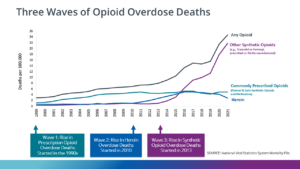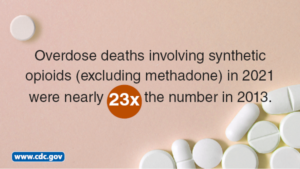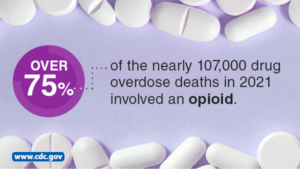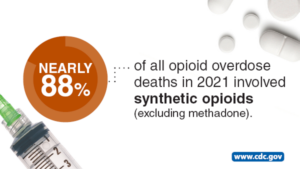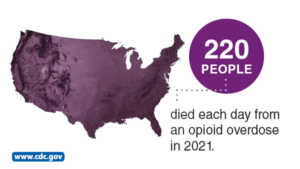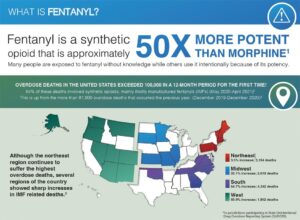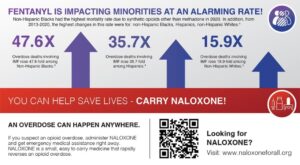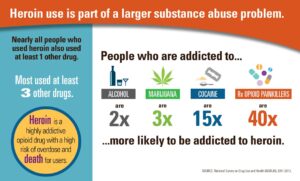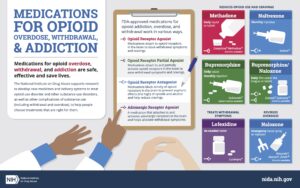Statistics on Opioid Trends in the United States
Opioids are a class of drugs used to reduce pain.
These include the illegal drug heroin, synthetic opioids such as fentanyl, and pain relievers available legally by prescription, such as oxycodone (OxyContin®), hydrocodone (Vicodin®), codeine, morphine, and many others.1
Opioids carry risks due to their high addiction potential, often leading to overdoses and fatalities.
Types of Opioids
Prescription opioids can be prescribed by doctors to treat moderate to severe pain but can also have serious risks and side effects.
- In 2021, more than 14.3 million Americans age 12 or older reported misusing any prescription psychotherapeutic drug in the past year; 3.7 million Americans age 12 or older reported misusing prescription pain relievers in the past year.2
In addition to the serious risks of addiction, abuse, and overdose, the use of prescription opioids can have a number of side effects, even when taken as directed:
- Tolerance—meaning you might need to take more of the medication for the same pain relief
- Physical dependence—meaning you have symptoms of withdrawal when the medication is stopped
- Increased sensitivity to pain
- Constipation
- Nausea, vomiting, and dry mouth
- Sleepiness and dizziness
- Confusion
- Depression
- Low levels of testosterone that can result in lower sex drive, energy, and strength
- Itching and sweating
Fentanyl is a synthetic opioid pain reliever. It is many times more powerful than other opioids and is approved for treating severe pain, typically advanced cancer pain.3 Illegally made and distributed fentanyl has been on the rise in several states.
- Rates of overdose deaths involving synthetic opioids other than methadone, which includes fentanyl and fentanyl analogs, increased over 56% from 2019 to 2020.4
Heroin is an illegal opioid.
- 25 people die every day from an overdose death involving heroin in the United States.5
- Over 11% of all opioid overdose deaths in 2021 involved heroin.5
Understanding Tolerance v. Dependence v. Addiction
Extended usage of prescription opioids, even under a doctor’s guidance, can lead certain individuals to build a tolerance. This implies that they may require increased or more frequent doses of the medication to achieve the intended results.1
Drug dependence arises from repeated use, causing neurons to adapt and become reliant on the substance for normal functioning. The absence of the drug triggers a range of physiological reactions, varying from mild, as seen with caffeine, to potentially life-threatening, as observed with heroin. Among chronic pain patients, some are dependent on opioids and may need medical support to discontinue their use.1
Drug addiction is a chronic disease marked by uncontrollable and compulsive drug seeking and consumption, even in the face of harmful outcomes, alongside enduring alterations in the brain. These alterations can lead individuals, whether they misuse prescription or illicit drugs, to engage in damaging behaviors.1
Established, safe, and effective treatments are available for those seeking relief. When administered by trained professionals, these treatments can guide individuals towards a healthier lifestyle, free from the burdens of addiction symptoms. More information can be found in this E-Book, Opioid Addiction Treatment: A Guide for Patients, Families and Friends.
Also available in other languages.
For more information, please visit: https://www.cdc.gov/opioids/index.html
1 NIDA. 2021, June 1. Prescription Opioids DrugFacts. Retrieved from https://nida.nih.gov/publications/drugfacts/prescription-opioids
2 NIDA. 2023, February 13. What is the scope of prescription drug misuse in the United States?. Retrieved from https://nida.nih.gov/publications/research-reports/misuse-prescription-drugs/what-scope-prescription-drug-misuse
3 Algren D, Monteilh C, Rubin C, et al. Fentanyl-associated fatalities among illicit drug users in Wayne County, Michigan (July 2005-May 2006).Journal Of Medical Toxicology: Official Journal of the American College Of Medical Toxicology [serial online]. March 2013; 9(1):106-115.
4 Hedegaard H, Miniño AM, Spencer MR, Warner M. Drug overdose deaths in the United States, 1999–2020. NCHS Data Brief, no 428. Hyattsville, MD: National Center for Health Statistics. 2021. DOI: https://dx.doi.org/10.15620/cdc:112340external icon
5 Wide-ranging online data for epidemiologic research (WONDER). Atlanta, GA: CDC, National Center for Health Statistics; 2022. Available at http://wonder.cdc.gov



